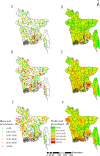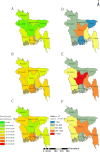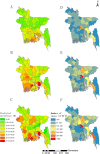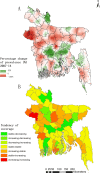High-resolution mapping of reproductive tract infections among women of childbearing age in Bangladesh: a spatial-temporal analysis of the demographic and health survey
- PMID: 33579253
- PMCID: PMC7881647
- DOI: 10.1186/s12889-021-10360-4
High-resolution mapping of reproductive tract infections among women of childbearing age in Bangladesh: a spatial-temporal analysis of the demographic and health survey
Abstract
Background: Reproductive tract infections (RTIs) have become major but silent public health problems devastating women's lives in Bangladesh. Accurately and precisely identifying high-risk areas of RTIs through high-resolution risk maps is meaningful for resource-limited settings.
Methods: We obtained data reported with RTI symptoms by women of childbearing age in the years 2007, 2011 and 2014 from Bangladesh Demographic and Health Survey. High-spatial Environmental, socio-economic and demographic layers were downloaded from different open-access data sources. We applied Bayesian spatial-temporal models to identify important influencing factors and to estimate the infection risk at 5 km spatial resolution across survey years in Bangladesh.
Results: We estimated that in Bangladesh, there were approximate 11.1% (95% Bayesian credible interval, BCI: 10.5-11.7%), 13.9% (95% BCI: 13.3-14.5%) and 13.4% (95% BCI: 12.8-14.0%) of women of childbearing age reported with RTI symptoms in 2007, 2011 and 2014, respectively. The risk of most areas shows an obvious increase from 2007 to 2011, then became stable between 2011 and 2014. High risk areas were identified in the southern coastal areas, the western Rajshahi Division, the middle of Khulna Division, and the southwestern Chittagong Division in 2014. The prevalence of Rajshahi and Nawabganj District were increasing during all the survey years.
Conclusion: The high-resolution risk maps of RTIs we produced can guide the control strategies targeted to priority areas cost-effectively. More than one eighth of women of childbearing age reported symptoms suggesting RTIs and the risk of RTIs varies in different geographical area, urging the government to pay more attention to the worrying situation of female RTIs in the country.
Keywords: Bangladesh; High-resolution map; Reproductive tract infections; Spatial-temporal analysis.
Conflict of interest statement
The authors declare no competing interests.
Figures





References
-
- United Nations . Resolution adopted by the UN general assembly on 25 September 2015. New York: United Nations; 2015. Transforming our world: the 2030 agenda for sustainable development.
-
- Starrs AM, Ezeh AC, Barker G, Basu A, Bertrand JT, Blum R, Coll-Seck AM, Grover A, Laski L, Roa M, et al. Accelerate progress-sexual and reproductive health and rights for all: report of the Guttmacher-Lancet commission. Lancet. 2018;391(10140):2642–2692. doi: 10.1016/S0140-6736(18)30293-9. - DOI - PubMed
-
- World Health Organization . Global prevalence and incidence of selected curable sexually transmitted infections: overview and estimates. Geneva: World Health Organization; 2001.
-
- Population Council . Reproductive tract infections: an introductory overview. 2013.
Publication types
MeSH terms
Grants and funding
LinkOut - more resources
Full Text Sources
Other Literature Sources

